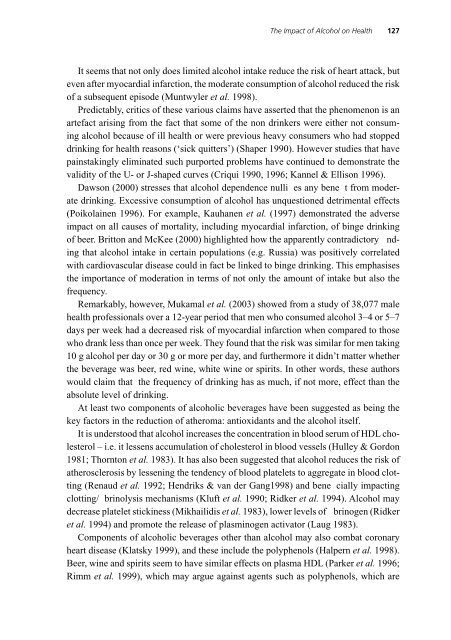Beer : Health and Nutrition
Beer : Health and Nutrition
Beer : Health and Nutrition
You also want an ePaper? Increase the reach of your titles
YUMPU automatically turns print PDFs into web optimized ePapers that Google loves.
The Impact of Alcohol on <strong>Health</strong> 127<br />
It seems that not only does limited alcohol intake reduce the risk of heart attack, but<br />
even after myocardial infarction, the moderate consumption of alcohol reduced the risk<br />
of a subsequent episode (Muntwyler et al. 1998).<br />
Predictably, critics of these various claims have asserted that the phenomenon is an<br />
artefact arising from the fact that some of the non drinkers were either not consuming<br />
alcohol because of ill health or were previous heavy consumers who had stopped<br />
drinking for health reasons (‘sick quitters’) (Shaper 1990). However studies that have<br />
painstakingly eliminated such purported problems have continued to demonstrate the<br />
validity of the U- or J-shaped curves (Criqui 1990, 1996; Kannel & Ellison 1996).<br />
Dawson (2000) stresses that alcohol dependence nulli es any bene t from moderate<br />
drinking. Excessive consumption of alcohol has unquestioned detrimental effects<br />
(Poikolainen 1996). For example, Kauhanen et al. (1997) demonstrated the adverse<br />
impact on all causes of mortality, including myocardial infarction, of binge drinking<br />
of beer. Britton <strong>and</strong> McKee (2000) highlighted how the apparently contradictory nding<br />
that alcohol intake in certain populations (e.g. Russia) was positively correlated<br />
with cardiovascular disease could in fact be linked to binge drinking. This emphasises<br />
the importance of moderation in terms of not only the amount of intake but also the<br />
frequency.<br />
Remarkably, however, Mukamal et al. (2003) showed from a study of 38,077 male<br />
health professionals over a 12-year period that men who consumed alcohol 3–4 or 5–7<br />
days per week had a decreased risk of myocardial infarction when compared to those<br />
who drank less than once per week. They found that the risk was similar for men taking<br />
10 g alcohol per day or 30 g or more per day, <strong>and</strong> furthermore it didn’t matter whether<br />
the beverage was beer, red wine, white wine or spirits. In other words, these authors<br />
would claim that the frequency of drinking has as much, if not more, effect than the<br />
absolute level of drinking.<br />
At least two components of alcoholic beverages have been suggested as being the<br />
key factors in the reduction of atheroma: antioxidants <strong>and</strong> the alcohol itself.<br />
It is understood that alcohol increases the concentration in blood serum of HDL cholesterol<br />
– i.e. it lessens accumulation of cholesterol in blood vessels (Hulley & Gordon<br />
1981; Thornton et al. 1983). It has also been suggested that alcohol reduces the risk of<br />
atherosclerosis by lessening the tendency of blood platelets to aggregate in blood clotting<br />
(Renaud et al. 1992; Hendriks & van der Gang1998) <strong>and</strong> bene cially impacting<br />
clotting/ brinolysis mechanisms (Kluft et al. 1990; Ridker et al. 1994). Alcohol may<br />
decrease platelet stickiness (Mikhailidis et al. 1983), lower levels of brinogen (Ridker<br />
et al. 1994) <strong>and</strong> promote the release of plasminogen activator (Laug 1983).<br />
Components of alcoholic beverages other than alcohol may also combat coronary<br />
heart disease (Klatsky 1999), <strong>and</strong> these include the polyphenols (Halpern et al. 1998).<br />
<strong>Beer</strong>, wine <strong>and</strong> spirits seem to have similar effects on plasma HDL (Parker et al. 1996;<br />
Rimm et al. 1999), which may argue against agents such as polyphenols, which are

















